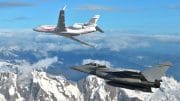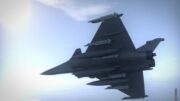Dassault Aviation and ISAE-SUPAERO renew their collaboration
on the “Design and Architecture of Cognitive Air Systems”
Research Chair
The “Design and Architecture of Cognitive Air Systems” teaching and research chair, initiated in 2016 by Dassault Aviation, ISAE-SUPAERO and its Foundation, aims at rethinking the relationship between crews and systems used in aviation. After some first promising results, the two aviation actors have decided to renew their partnership for another three years.
Work aiming to optimize Human-Machine interaction
This chair, whose principal areas of research are neuro-ergonomics, automated decision- making and systems engineering, aims to study different aspects of human-machine collaboration. The idea is to make civil and military aviation operations more robust, efficient and safer, while guaranteeing complete crew control.
The systems considered are often operated in complex situations, so they feature advanced automated decision-making algorithms from the field of artificial intelligence (AI) to carry out their missions more independently, but always under human control.
At ISAE-SUPAERO, the Department of Aerospace Vehicles Design and Control (DCAS) has expertise in neuro-ergonomics and AI for systems control. The field of neuro-ergonomics analyses brain function and user behaviors at work through the lens of neuroscience. In practical terms, it involves evaluating the mental state of users in relation to their ability to complete the tasks assigned to them. AI for system control is the field that develops algorithms for automated decision-making. The decisions concern, for example, the set of tasks to be suggested to the operator or to be fully automated to alleviate the operator’s workload and improve their performance in the operating context.
“Dassault Aviation is particularly interested in issues surrounding Human-Machine interaction because military aviation is a very demanding field due to the variety and unpredictability of missions which require complex tactical management. The challenge lies in providing Humans with all the services they need to take responsibility for this management. This is why we are working with ISAE-SUPAERO in order to identify the phenomena that impact collaboration between crews and their machines”, says Jean-Louis Gueneau, Scientific Coordinator of the chair at Dassault Aviation.
First conclusive results
The work conducted by the research chair on Human-Machine interaction from 2016 to 2021 led to the development of different tools based on physiological measurements, as well as machine learning techniques and automated action planning. The teams particularly focused
on developing active or passive assistance functions to help pilots and operators improve their performance.
To do so, work was initially centered on “Pilot Monitoring” to gain a better understanding of the crew’s activity. Experiments were conducted on simulators using behavioral and physiological measurement tools to determine metrics capable of evaluating the operator’s performance, and their level of engagement or stress.
Dassault Aviation are planning to integrate these functions into their civil and military aircraft within the next decade.
The machine, the operator’s teammate
“This chair focuses primarily on the development of innovative technologies that contribute, on the one hand, to qualify the human-machine interaction to see whether the collaboration is efficient, and on the other, to automatically decide what should be maintained, proposed, or changed to foster the team’s performance”, explains Caroline Chanel, Chair Manager at ISAE-SUPAERO.
For this purpose, quantitative behavioral and physiological metrics will be combined with more qualitative metrics to evaluate the efficiency of Human-Machine cooperation. This efficiency assessment will then be used by AI algorithms to adapt and enhance the cooperation. These innovative topics are of interest to industrial firms and researchers with a view to developing concrete applications in the long term.
ABOUT DASSAULT AVIATION
With over 10,000 military and civil aircraft (including 2,500 Falcons) delivered in more than 90 countries over the last century,
Dassault Aviation has built up expertise recognized worldwide in the design, development, sale and support of all types of
aircraft, ranging from the Rafale fighter, to the high-end Falcon family of business jets, military drones and space systems. In
2021, Dassault Aviation reported revenues of €7.2 billion. The company has 12,400 employees.
dassault-aviation.com
ABOUT ISAE-SUPAERO
A world leader in higher education and research in aerospace engineering, ISAE-SUPAERO is a research and innovation-driven institution of higher education, committed to balancing scientific excellence, academic visibility and proximity to industrial objectives. It offers a complete, unique range of advanced higher education programs including “the Ingénieur ISAE-SUPAERO” (MSc) Degree and a apprenticeship program, 1 master in aeronautics and space delivered in English, 6 research masters, 15 advanced masters, and 6 Doctoral schools
ISAE-SUPAERO has developed a research policy resolutely focused on answering the future needs of the aerospace industry and other high technology sectors. Close collaboration with industry is reflected in the Institution’s ongoing commitment to developing teaching and research chairs in strategic fields such as neuroergonomics and human factors, advanced space concepts, embedded systems engineering, eco-design for aircraft or innovative propulsive systems. 5 chairs are currently in progress with Daher, Axa, Airbus, Dassault, Arianegroup.
On the international level, ISAE-SUPAERO cooperates with premier European universities (TU Munich, TU Delft, ETSIA Madrid, Politecnico Torino et Milano, KTH Stockholm, Imperial College, Cranfield), North American institutions (Caltech, Stanford, Georgia Tech, UC Berkeley, EP Montreal…) and Latin American and Asian universities as well.
The ISAE-SUPAERO includes 1900 undergraduate students. Every year, over 30% of the Institute’s graduates are international students, and the alumni network includes over 24 000 former graduates.
ABOUT THE ISAE-SUPAERO FOUNDATION
The ISAE-SUPAERO Foundation was recognized as being in the public interest in 2008. It works to develop ISAE-SUPAERO’s world standing and leadership by offering and accelerating the completion of innovative projects that contribute to a sustainable world. Its actions are built around five objectives: promote the development of aerospace research, consolidate the innovative teaching tools proposed, further entrepreneurship, support the international mobility of lecturer-researchers and students, and encourage the social outreach policy particularly by supporting the Institute’s diversity program, OSE ISAE-SUPAERO, with the French Aerospace Industries Association (GIFAS).









Be the first to comment on "Dassault Aviation ISAE Research Chair"